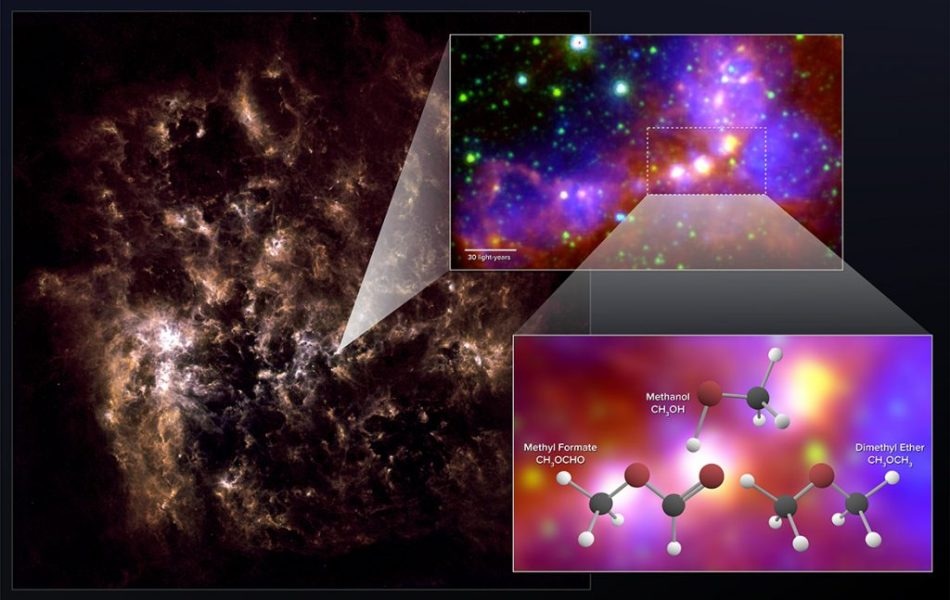Jan 31 2018
The Large Magellanic Cloud (LMC), which is the nearby dwarf galaxy, is a chemically primitive region.
 Astronomers using ALMA have uncovered chemical “fingerprints” of methanol, dimethyl ether and methyl formate in the Large Magellanic Cloud. The latter two molecules are the largest organic molecules ever conclusively detected outside the Milky Way. The far-infrared image on the left shows the full galaxy. The zoom-in image shows the star-forming region observed by ALMA. It is a combination of mid-infrared data from Spitzer and visible (H-alpha) data from the Blanco 4-meter telescope. (Image credit: NRAO/AUI/NSF; ALMA (ESO/NAOJ/NRAO); Herschel/ESA; NASA/JPL-Caltech; NOAO)
Astronomers using ALMA have uncovered chemical “fingerprints” of methanol, dimethyl ether and methyl formate in the Large Magellanic Cloud. The latter two molecules are the largest organic molecules ever conclusively detected outside the Milky Way. The far-infrared image on the left shows the full galaxy. The zoom-in image shows the star-forming region observed by ALMA. It is a combination of mid-infrared data from Spitzer and visible (H-alpha) data from the Blanco 4-meter telescope. (Image credit: NRAO/AUI/NSF; ALMA (ESO/NAOJ/NRAO); Herschel/ESA; NASA/JPL-Caltech; NOAO)
In contrast to the Milky Way, this semi-spiral group of a few tens-of-billions of stars is short of heavy elements such as oxygen, carbon, and nitrogen. With this lack of heavy elements, astronomers predict that the LMC should include a relatively trivial amount of complex carbon-based molecules. Earlier observations of the LMC appear to reiterate this perspective.
However, fresh observations by using the Atacama Large Millimeter/submillimeter Array (ALMA) have revealed the astonishingly clear chemical “fingerprints” of the complex organic molecules such as dimethyl ether, methanol, and methyl formate. Although earlier observations discovered traces of methanol in the LMC, the discovery of dimethyl ether and methyl formate is unparalleled, and they are the most complex molecules to have been ever definitively found outside the Milky Way galaxy.
Astronomers spotted the feeble millimeter-wavelength “glow” of the molecules emerging from two dense star-forming embryos in the LMC, or regions called “hot cores.” These observations might offer an in-depth understanding of the evolution of comparably complex organic molecules early in the history of the universe.
Even though the Large Magellanic Cloud is one of our nearest galactic companions, we expect it should share some uncanny chemical similarity with distant, young galaxies from the early universe
Marta Sewiło, Astronomer with NASA’s Goddard Space Flight Center
Astronomers term this deficit of heavy elements as “low metallicity.” It takes a number of generations of genesis and demise of stars to generously feed a galaxy with heavy elements, which are then absorbed by the next-generation stars and begin to be the foundation of new planets.
Young, primordial galaxies simply didn’t have enough time to become so chemically enriched. Dwarf galaxies like the LMC probably retained this same youthful makeup because of their relatively low masses, which severely throttles back the pace of star formation.
Marta Sewiło, Astronomer with NASA’s Goddard Space Flight Center
“Due to its low metallicity, the LMC offers a window into these early, adolescent galaxies,” stated Remy Indebetouw, an astronomer at the National Radio Astronomy Observatory in Charlottesville, Virginia, and coauthor of the work. “Star-formation studies of this galaxy provide a stepping stone to understand star formation in the early universe.”
The focus of the astronomers was on the N113 Star Formation Region in the LMC, one of the most expansive and gas-rich regions of the galaxy. Previous observations of this region by using NASA’s Spitzer Space Telescope and ESA’s Herschel Space Observatory disclosed an astonishing concentration of young stellar objects, or protostars that have shortly started to heat their stellar nurseries, making them to glow brightly under infrared light. At least, a part of this star formation is the result of a domino-like effect, under which the genesis of massive stars initiates the formation of various stars in the same general surroundings.
Sewiło and her team adopted ALMA to investigate a number of young stellar objects in this area to have a better knowledge of their dynamics and chemistry. The ALMA data astonishingly disclosed the indicative spectral signatures of methyl formate and dimethyl ether—molecules that have not been found on Earth till date.
Complex organic molecules, which include six or more atoms apart from carbon, are some of the fundamental building blocks of molecules that are indispensable for life on Earth and, probably, in other regions of the universe. Although methanol is a comparatively simple compound than other organic molecules, it is crucial for the formation of highly complex organic molecules, such as those recently observed by ALMA, among others.
In case such complex molecules can readily form surrounding the protostars, it is highly possible that they would last for a long time and form part of the protoplanetary disks of young star systems. Molecules such as these were probably delivered to the primitive Earth by meteorites and comets, assisting in initiating the development of life on Earth.
The astronomers hypothesize that as complex organic molecules could form in chemically primitive environments such as the LMC, it is probable that the chemical framework for life might have appeared comparatively early in the history of the universe.
The National Radio Astronomy Observatory is a facility of the National Science Foundation, functioning under cooperative agreement by Associated Universities, Inc.